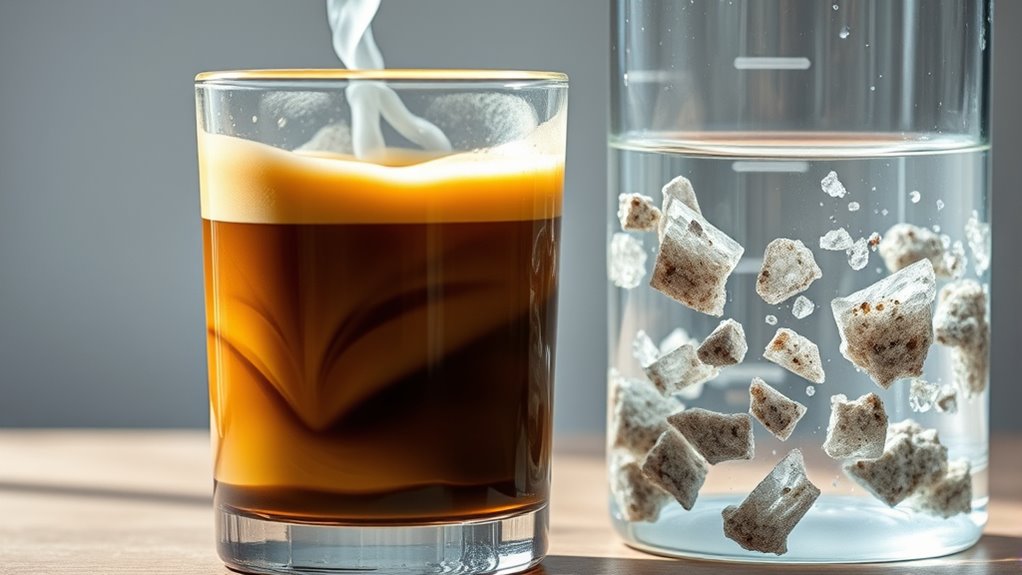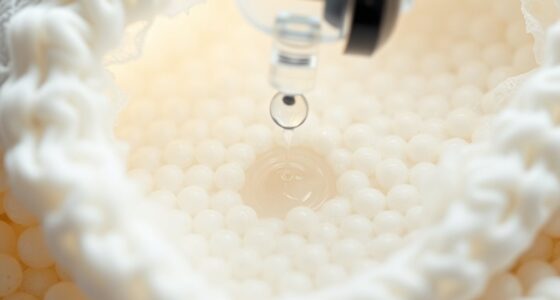Yes, chemistry affects how your coffee tastes by showing how water mineral content and temperature influence flavor extraction. Hard water with calcium and magnesium can boost richness but risks bitterness, while soft water may lead to flatter brews. Maintaining the right temperature guarantees soluble compounds develop fully for a balanced taste. If you keep exploring, you’ll discover how adjusting these factors can truly elevate your coffee experience.
Key Takeaways
- Water mineral content, especially calcium and magnesium, influences flavor extraction and enhances coffee’s richness.
- Proper water hardness prevents over- or under-extraction, ensuring balanced, flavorful brews.
- Maintaining optimal brewing temperatures (195°F–205°F) maximizes extraction and preserves aroma.
- Adjusting water chemistry and temperature allows for tailored flavor profiles and better coffee quality.
- Understanding coffee chemistry enables precise control over brewing conditions for consistent, improved taste.

Have you ever wondered what makes your morning coffee so irresistible? It’s not just the beans or the brewing method—it’s also the chemistry behind the water you use. Two key factors influence the flavor and quality of your brew: water mineral content and brewing temperature. Understanding how these elements work together can help you craft a better cup every time.
First, consider water mineral content. This refers to the types and amounts of minerals dissolved in your water—mainly calcium, magnesium, sodium, and trace elements. Hard water, rich in calcium and magnesium, can enhance the extraction of flavors from coffee grounds, resulting in a richer, more complex taste. However, too much mineral content can lead to over-extraction, making your coffee bitter or metallic.
Conversely, soft water, with fewer minerals, might produce a flatter, less vibrant brew because it doesn’t extract enough flavor compounds. The ideal mineral content balances the extraction process, highlighting the coffee’s natural flavors without overwhelming them. It’s why some coffee enthusiasts prefer filtered or mineral-enhanced water, tailoring mineral levels to match their taste preferences and brewing style.
Next, think about brewing temperature. The perfect range generally falls between 195°F and 205°F (90°C to 96°C). Brewing within this temperature window ensures that the soluble compounds in coffee dissolve efficiently, releasing their aromatic oils and flavors.
If your water is too hot, you risk over-extraction, which can lead to bitterness and a burnt taste. Too cool, and you might under-extract, leaving your coffee weak, sour, or lacking depth. The temperature influences how well the water interacts with coffee grounds, affecting both extraction speed and flavor profile.
Accurate temperature control during brewing is vital—using a quality coffee maker with temperature regulation or a thermometer can make a noticeable difference in your cup’s taste.
Together, water mineral content and brewing temperature form the core of coffee chemistry. They’re not just technical details; they’re tools you can manipulate to refine your brewing process. Adjusting mineral levels can bring out specific flavor notes, while controlling temperature guarantees consistent extraction.
Additionally, understanding water hardness can help you make informed decisions about water treatment options to optimize your brew. When you pay attention to these elements, you’re not just brewing coffee—you’re conducting a chemistry experiment that results in a more satisfying, flavorful cup. So next time you pour your brew, think about how water chemistry influences each sip, and consider experimenting with mineral content and temperature to reveal new layers of flavor.
Mastering these factors can turn an ordinary cup into a truly exceptional experience.
Frequently Asked Questions
How Does Water Temperature Affect Coffee Flavor?
You’ll notice that water temperature markedly impacts coffee flavor. When water is too hot, it can extract bitter compounds, while too cool water may under-extract, resulting in a weak taste.
Ideal temperature balances extraction, considering water pH and brewing time. Consistently maintaining proper temperature guarantees the best flavor, highlighting acidity and aroma, and prevents over or under-extraction.
Adjusting water temperature helps you craft a well-balanced, flavorful cup every time.
What Role Does Acidity Play in Coffee Taste?
Acidity substantially influences your coffee’s taste by affecting its pH balance. When the acidity is just right, it enhances bright, fruity, and tangy notes, making the flavor lively.
However, too much acidity can increase sourness perception, overshadowing other flavors. You want a balanced acidity to enjoy a well-rounded, flavorful cup.
Adjusting brewing parameters or bean selection can help manage acidity levels, ensuring your coffee tastes just how you like it.
Can Different Brewing Methods Influence Flavor Extraction?
Think of brewing methods as different musical instruments shaping the flavor of your coffee. You influence this by choosing your coffee grind and brewing equipment.
For instance, a French press extracts more oils, creating a fuller taste, while pour-over highlights delicate notes. Each method controls extraction, so experimenting with various techniques can turn a good cup into a great one, tailored perfectly to your flavor preferences.
How Do Coffee Bean Varieties Interact With Water Chemistry?
You’ll find that coffee bean origin and water mineral content profoundly influence interaction. Different bean varieties have unique flavor profiles that react differently to water chemistry.
For instance, some beans prefer soft water with low mineral content to highlight delicate notes, while others thrive with mineral-rich water to enhance bold flavors. Adjusting water chemistry based on the bean’s origin can bring out the best in each variety, elevating your brewing experience.
Does the Age of Water Impact Coffee Quality?
Imagine water as a living story, with each chapter influencing your coffee’s flavor. The age of water affects mineralization and pH stability, which in turn impacts taste.
Fresh water often offers ideal mineral balance, while older water may lose essential minerals or develop pH fluctuations.
Choosing water with proper mineralization and stable pH ensures your brew remains vibrant and flavorful, no matter how long it’s been stored.
Conclusion
So, now that you know how water hardness influences your coffee’s flavor, isn’t it worth experimenting with different water types? Chemistry shows that small tweaks can make a big difference in your brew’s taste and aroma. By understanding these science-backed tips, you can craft the perfect cup every time. After all, isn’t better coffee just a few mineral adjustments away? Cheers to improving your morning ritual with a bit of science!









